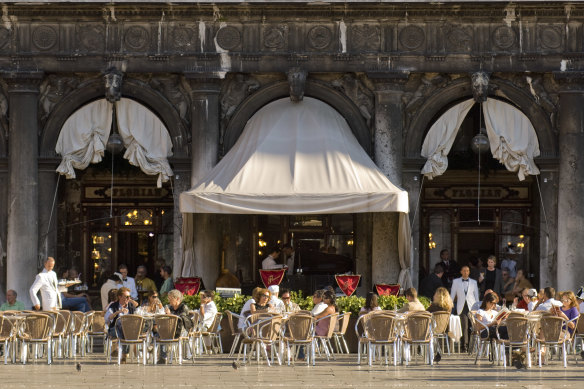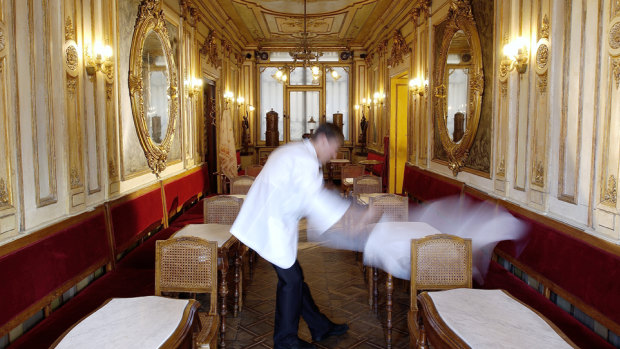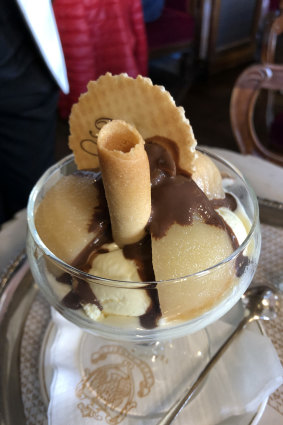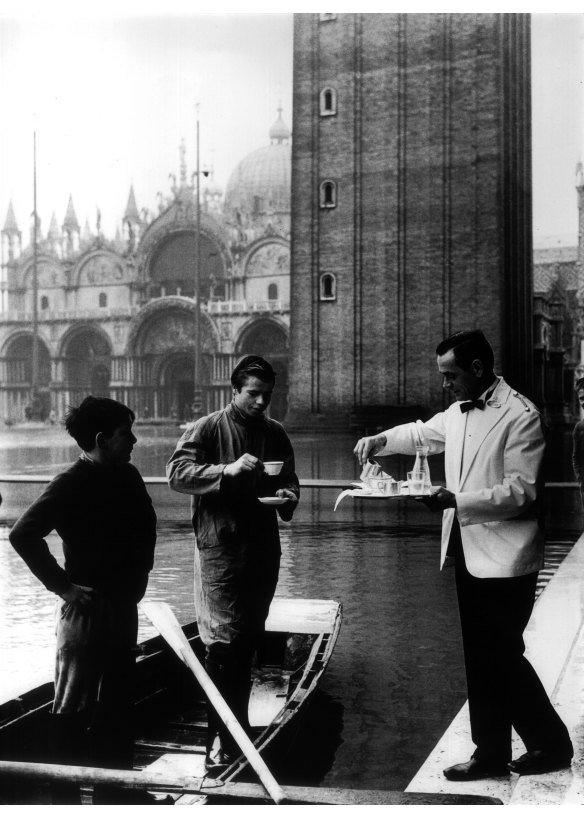This was published 5 years ago
Please, sit down. It's time for good coffee and great history
Venice: One of my golden rules has been to avoid writing about myself at all costs. Journalists should tell the story but never be the story. I have been determined to deploy the word ''I'' sparingly and using it twice in this very sentence makes me shudder.
But how else to tell you about Caffe Florian without sharing the details of my recent visit? It was such a joyful, restorative experience that the rule book is briefly being put to one side in the hope of convincing you to one day walk through its historic doors.

Venice's Caffe Florian has been trading for 300 years.
The two main things you need to know about visiting Caffe Florian are that it is really old, and that it is not cheap. You won't walk out having spent less than €10 ($17) on a single coffee.
But who cares? You're in one of the world's most beautiful cities, and sitting inside an institution that has witnessed some of Europe's most turbulent moments and played host to renowned figures such as Casanova, Lord Byron, Madame de Stael and Marcel Proust. This is no time to scrimp.
No, this is a time for good coffee. And great history.
The cafe was originally named Alla Venezia Trionfante (Triumphant Venice) when it opened under the imposing arches of Procuratie Nuove in St Mark's Square in 1720, but locals affectionately dubbed it "Florian's" after owner Floriano Francesconi and the name stuck.

Caffe Florian was serving coffee for 50 years before Captain Cook landed in Botany Bay.
It has been in the same spot for three centuries, earning it the title of the world's oldest continuously operating cafe. To put its longevity in context, Florian was serving coffee for 50 years before Captain Cook landed in Botany Bay. Even more remarkable is that it has managed to retain its unique identity despite all the social, economic and political upheaval that would unfold on the square outside and sometimes inside the cafe's own 24-carat gold-leafed walls.
It was no different when I visited. Coronavirus had broken out in northern Italy and Caffe Florian was again witnessing history as tourists scrambled from Venice. Some locals said their island city had never been so quiet.
I arrived at the cafe slightly drained from a week on the road covering the outbreak and distressed by the obvious economic damage being inflicted on the people of Italy.

Caffe Florian's Coppa Bella Elena is served to the author.Credit: Bevan Shields
But walking through the mahogany double doors was an instant tonic. A beaming waiter dressed in an impossibly white jacket welcomed me like I was family and showed me to a table with a great view of St Mark's Square. If he was worried about the coronavirus-induced downturn, he wasn't prepared to show it.
I ordered a double espresso and the Coppa Bella Elena (vanilla ice cream, pear in syrup and a small side of Florian hot chocolate that is poured over the whole ensemble). It's seriously good. And, in a nice touch, arrives on a silver tray carefully placed on a marble table that has been in that same spot since 1858.
The whole experience was a reminder that sometimes there are few things better than good hospitality.
I took out my phone to do some research but there was no need: the cafe's assistant director, Anna Rita Panebianco, walked by and struck up a conversation.
"This place has seen world wars and high tides," she said. "This was where people used to meet and organise themselves during the revolution.
"This is an institution, a place of resilience. It's something that Venetian people feel is their heritage and feel is part of their home."

A waiter serves coffee during a flood in Venice.Credit:
Panebianco took me through the history of the building and the cafe's unique layout. It is split into multiple ''rooms'': the Chinese Room, the Hall of the Senate, the Oriental Room, the Hall of Seasons and the Liberty Room. Each has a distinctive decor that is remarkably well preserved in spite of the ravages of time and a temperate Adriatic Sea. In summer, hundreds of guests sit on tables and chairs outside in St Mark's Square as an orchestra plays.
Panebianco gave me the perfect answer when I asked a cliched question: What's the secret to staying in business for 300 years?
"When Floriana Francesconi first opened there were maybe 200 coffee houses in Venice. What made the difference then was the human factor, the way he could welcome people and the way people felt in these walls inside.
"Today is the same. It is all about the human factor. We feel we are part of history and want to welcome people to that story."
If you're ever in Italy, make sure you share in it too.